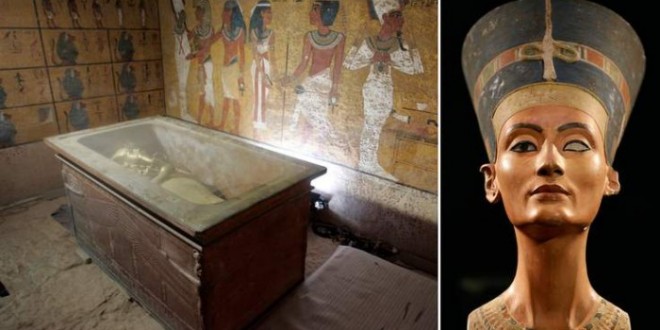Egyptian authorities say that they will obtain the radar equipment needed to complete the search for Queen Nefertiti’s tomb.
Dr Nicholas Reeves of the University of Arizona has been using radar and thermal imaging to examine the walls of King Tutankhamun’s tomb.
He says it has provided strong evidence that Nefertiti lies hidden behind two doorways in the king’s burial chamber.
Nefertiti was the chief consort of the pharaoh Akhenaten in the 14th Century BC and her location is one of the enduring mysteries of Egyptology.
Dr Reeves formed his theory after analysing photographs of King Tut’s tomb, which was uncovered by English archaeologist Howard Carter in the Valley of the Kings in 1922.
The photos were published by the art replication specialists Factum Arte in 2014, and were used to create a facsimile of Tutankhamun’s burial chamber.
Dr Reeves told a news conference in the Egyptian capital Cairo “completely new evidence” had been “yielded by a technology to which previous generations had no access”.
“The additional scanning of surfaces… has revealed the seeming presence of two intact doorways behind the painting decoration of the burial chambers west and north walls.
“More extraordinary still, it looks as if one of these doorways may lead to the burial of Nefertiti herself.”
Dr Reeves added: “Even before these latest developments, it was becoming apparent to a number of scholars that Tutankhamun’s tomb represents a far more complex assemblage than has previously been recognised.”
One example, he said, was Tutankhamun’s “famous gold mask”. The pierced ears indicated it was intended for a woman – and that woman was Nefertiti, the original occupant of the mausoleum.
Dr Reeves said all the evidence pointed to the presence behind the west wall of “a further Tutankhamun era storage room”.
He went on: “If this new chamber actually exists, and radar and thermal imaging should tell us, then from the intact condition of the painted decoration that now overlies it, the likelihood must be that it remains completely undisturbed.”
Egyptian Antiquities Minister Mamdouh al Damaty said further scanning could begin in the next one to three months.
If it did lead to Nefertiti’s remains being found, he said it “would overshadow the discovery of Tutankhamun himself”.
Scholarly debate about Nefertiti’s burial place has persisted for more than a century.
Some believe she was buried in Amarna, an ancient capital city founded by Pharaoh Akhenaten.
Others believe one of two mummies found in the Valley of the Kings, known as the “Elder Lady” and the “Younger Lady”, may also be her.
Agencies/Canadajournal
 Canada Journal – News of the World Articles and videos to bring you the biggest Canadian news stories from across the country every day
Canada Journal – News of the World Articles and videos to bring you the biggest Canadian news stories from across the country every day



